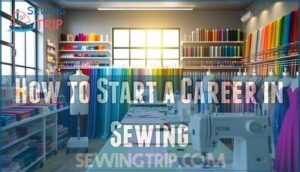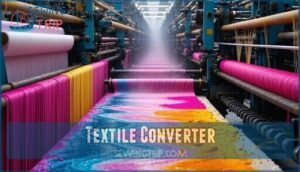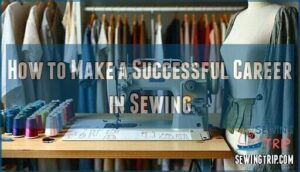This site is supported by our readers. We may earn a commission, at no cost to you, if you purchase through links.

Popular paths include fashion designer, seamstress, patternmaker, and alterations specialist. Manufacturing roles like sewing machine operator and production worker offer steady employment, while creative positions such as costume designer and textile artist let you express artistic vision.
Technical careers include textile engineer, quality control inspector, and product developer. You can work in retail as a sales associate or buyer, or start your own alteration business.
From entry-level positions requiring basic skills to advanced roles needing specialized training, the sewing industry offers opportunities at every experience level. The key is matching your interests with the right specialization.
Table Of Contents
- Key Takeaways
- Sewing Careers in The Textile Industry
- Sewing Careers in The Sewing Industry
- Fashion Careers in The Textile Industry
- How to Start a Career in Sewing
- Textile Careers for Diploma Holders
- Career Paths in The Fashion Industry
- Opportunities for Sewing Careers
- How to Make a Successful Career in Sewing
- Exploring New Career Opportunities in The Textile Industry
- Careers in The Sewing Industry: a Comprehensive List
- Frequently Asked Questions (FAQs)
- Conclusion
Key Takeaways
- You’ll find over 150 career opportunities spanning entry-level positions, like sewing machine operator ($24,000), to specialized roles, like fashion designer ($50,000-$100,000), with pathways across manufacturing, retail, and creative sectors.
- Technical and creative paths offer different advantages: manufacturing roles provide steady employment, while design positions let you express your artistic vision, and you can advance from basic operator roles to supervisory positions.
- Education requirements vary significantly: entry-level positions offer on-the-job training, while specialized roles, like textile engineer or researcher, require degrees, making the field accessible at multiple skill levels.
- Industry trends favor sustainability and digital integration: you’ll need to stay current with eco-friendly practices and new technologies, while building both technical skills and business acumen for long-term success.
Sewing Careers in The Textile Industry
You’ll find the textile industry offers diverse career paths that combine technical skills with creative problem-solving.
These roles span from hands-on production work to strategic management positions, each contributing to the complex process of bringing fabrics and textiles to market, which requires creative problem-solving.
Material Handler
As a material handler in the textile industry, you’ll keep production lines running smoothly by managing raw materials, fabrics, and finished goods.
This entry-level position offers steady work at around $34,090 annually while you learn the sewing industry from the ground up.
- Inventory Management: Track fabric rolls, yarns, and supplies using barcode scanners and warehouse systems
- Supply Chains: Move materials between storage areas, production floors, and shipping docks efficiently
- Quality Assurance: Handle delicate textiles carefully to prevent damage during transport and storage
- Automation Impact: Operate forklifts and conveyor systems while adapting to new warehouse technologies
Material handlers form the backbone of textile sourcing operations.
You’ll gain valuable experience in sewing career paths while building skills that open doors to supervisor roles and other sewing job opportunities.
Production Worker
You’ll work directly with the machinery that transforms raw materials into finished garments.
In apparel manufacturing, production workers handle assembly techniques while maintaining quality assurance standards are met.
You’ll operate sewing machines, perform machine maintenance, and implement efficiency improvements throughout the production process.
Workplace safety remains essential as you advance from sewing machine operator to apparel production manager roles within these dynamic sewing careers.
Buyer
As a buyer in sewing careers, you’re the strategic mind behind textile purchases, earning around $68,700 annually. Your role combines trend forecasting with supplier negotiation to secure quality materials at competitive prices.
You’ll manage vendor relationships while ensuring ethical sourcing practices meet company standards. Your expertise in fashion merchandising drives inventory management decisions that impact entire product lines.
Quality assurance becomes your responsibility as you evaluate suppliers and materials. Retail buyer positions require strong analytical skills for apparel merchandising success.
- Analyzing global market data to predict fabric trends six months ahead
- Negotiating million-dollar contracts with overseas textile suppliers
- Balancing cost efficiency with sustainable sourcing requirements
Logistics Manager
Orchestrating seamless supply chain operations, you’ll earn around $82,800 annually as a logistics manager in the textile industry.
This role puts you at the heart of manufacturing efficiency, where your strategic sourcing decisions and workflow optimization keep production humming.
You’ll oversee inventory management systems that prevent costly stockouts while coordinating transportation partnerships.
Your expertise in production capacity planning guarantees materials flow smoothly from suppliers to finished garments.
Supply chain disruptions become puzzles you solve through contingency planning and real-time adjustments. To maintain efficiency, consider implementing lean principles within the factory.
Most positions require a bachelor’s degree plus experience with ERP systems and warehouse management software.
You’ll lead teams while analyzing data to cut costs by 15-30% annually.
Among sewing careers, logistics management offers excellent advancement potential into operations director roles, making it an attractive path in today’s manufacturing landscape.
Researcher
As a textile researcher, you’ll pioneer Material Science breakthroughs that reshape the industry.
Your Research Methods will focus on Sustainability Research, developing eco-friendly fibers and antimicrobial fabrics.
With median salaries reaching $79,000, this scientific research role demands expertise in Data Analysis and laboratory techniques.
You’ll collaborate with engineers and designers, driving Textile Innovation through rigorous studies, and most positions require master’s degrees in textile engineering or chemistry, making you a sought-after textile specialist.
Sewing Careers in The Sewing Industry
The sewing industry offers you hands-on careers that focus on fabric manipulation and garment finishing. You’ll find opportunities ranging from pressing and laundering to specialized alterations and furniture upholstery work.
Presser
As you master pressing techniques in the sewing industry, you’ll transform wrinkled garments into polished masterpieces.
This essential role in sewing careers offers steady work and skill development opportunities.
- Equipment Maintenance: Keep steam irons, presses, and automatic folders in peak condition through regular cleaning and calibration
- Fabric Handling: Apply appropriate temperature and pressure settings for delicate silks, sturdy cottons, and synthetic blends
- Quality Standards: Guarantee consistent, professional finishes that meet manufacturing specifications and customer expectations
- Efficiency Tips: Develop workflow systems that maximize productivity while maintaining attention to detail
- Career Growth: Advance from entry-level presser to supervisory roles overseeing pressing operations and training new team members
Earning approximately $28,838 annually, pressers play a vital job role in garment finishing, bridging the gap between production and final quality control in textile manufacturing.
Laundry Attendant
While pressers handle the finishing touches, laundry attendants keep the textile pipeline flowing smoothly.
You’ll earn around $30,921 annually managing washing, drying, and fabric care operations.
This sewing industry role requires strong laundry skills and equipment maintenance knowledge.
Your daily tasks involve stain removal, customer service interactions, and implementing efficiency tips to streamline operations.
Most sewing careers in this field offer on-the-job training, making it accessible for newcomers to the sewing industry.
| Core Responsibilities | Required Skills |
|---|---|
| Washing and drying garments | Stain removal expertise |
| Equipment maintenance | Customer service abilities |
| Quality fabric inspection | Physical stamina |
Job roles in laundry services connect directly to broader sewing opportunities, providing foundational experience in textile handling and garment care processes.
Weaver
Anyone can learn Loom Operation through hands-on practice with traditional or computerized equipment.
You’ll master Weaving Techniques that create diverse Fabric Structures, from basic plain weaves to complex patterns.
Understanding Textile History enriches your craft knowledge.
Modern Weaver Innovations include digital controls and smart textiles.
This weaver role in sewing careers offers steady textile jobs within the broader textile industry and sewing industry landscape.
Alterations Specialist
As an alterations specialist, you’ll transform ill-fitting garments into perfectly fitted pieces.
This sewing career combines technical precision with customer service, making you the go-to expert for clothing modifications.
Essential skills include:
- Garment Fitting – Measuring clients and evaluating how clothes should fit
- Custom Alterations – Adjusting seams, hems, and sleeves for perfect fit
- Bridal Alterations – Specializing in wedding dress modifications and fittings
- Vintage Restoration – Repairing and updating older garments with modern techniques.
Master repair techniques like taking in seams, adding darts, and reshaping garments.
Accurate fittings require specialized measuring tools.
Many alterations specialists work in tailor shops or start independent businesses, earning $25,000-$40,000 annually while helping customers love their clothes again.
Upholsterer
You’ll discover furniture upholstery combines your sewing expertise with woodworking knowledge.
As an upholsterer, you’ll master heavy-duty sewing machines and specialized tools for furniture restoration projects.
Antique upholstery requires careful fabric selection and modern techniques to preserve historical pieces.
Your upholstery business can capitalize on home decor trends favoring custom work, and you’ll reupholster furniture ranging from vintage chairs to contemporary sofas, earning around $40,300 annually while building lasting client relationships.
Fashion Careers in The Textile Industry
Fashion careers blend creativity with business skills to connect clothing with consumers.
You’ll find opportunities ranging from visual merchandising to personal styling that let you shape how people experience and purchase fashion.
Retail Merchandiser
Behind the scenes of every successful store, you’ll find a retail merchandiser orchestrating the perfect shopping experience.
As a retail merchandiser in sewing careers, you’ll analyze consumer trends and implement sales strategies that drive revenue.
Your expertise in visual merchandising transforms ordinary displays into compelling showcases that capture shoppers’ attention.
You’ll master display techniques while managing inventory management systems to guarantee the best product placement.
The fashion industry relies on your analytical skills to interpret sales data and coordinate with buyers.
This role combines creativity with strategic thinking, making it essential for retail sales success.
Retail Sales Associate
Working as a retail sales associate puts you on the front lines of fashion retail, where customer service skills meet product knowledge.
You’ll help shoppers find perfect items while mastering sales techniques that boost store revenue.
Your responsibilities include:
- Greeting customers and identifying their specific needs
- Demonstrating product knowledge about fabrics, fits, and styling
- Managing inventory through restocking and visual merchandising displays
- Processing transactions and handling returns professionally
This role develops your understanding of retail sales operations while building communication skills that transfer to other sewing careers.
Stylist
As a fashion stylist, you’ll transform clients’ appearances through strategic wardrobe consulting and personal branding expertise.
Your eye for fashion forecasting helps create stunning visual merchandising that reflects current stylist trends.
- Develop individual styling plans matching clients’ lifestyles and goals
- Curate wardrobes that enhance personal branding and confidence
- Stay ahead of fashion forecasting to advise on emerging trends
- Build reputation as trusted image consultant through exceptional wardrobe curation
Graphic Designer
Visual storytellers in fashion, you’ll craft compelling branding graphics using design software like Adobe Illustrator.
Create logos, web banners, and advertisements that capture a brand’s visual identity.
Master digital illustration and layout design while building a strong portfolio.
Your creative vision transforms fashion concepts into marketing materials that connect with customers across print and digital platforms.
Personal Shopper
Personal shoppers bridge the gap between client needs and perfect wardrobe building through expert styling expertise.
You’ll earn around $54,623 annually while mastering trend forecasting and budget management for diverse clients.
This fashion career combines retail sales associate skills with personal stylist intuition.
As a professional shopper, you’ll curate clothing that flatters each client’s unique style and lifestyle.
Your expertise transforms shopping from overwhelming chore into confidence-building experience.
Success requires understanding body types, current trends, and smart budget allocation while developing lasting client relationships.
How to Start a Career in Sewing
Starting a sewing career opens doors to creative and technical opportunities that blend craftsmanship with modern innovation.
You’ll find entry points through roles like sewing machine operator, textile design, or fashion design that can launch your professional journey.
Sewing Machine Operator
Becoming a sewing machine operator launches you into one of the sewing industry’s foundational roles. You’ll master industrial machines that create everything from designer garments to automotive upholstery.
This position demands precision, as productivity rates typically range from 200-400 units per shift.
Essential skills for success include:
- Machine Maintenance – cleaning, adjusting tension, and replacing components
- Ergonomics – positioning yourself properly to prevent repetitive strain injuries
- Skill Development – progressing from basic stitching to complex techniques
- Automation Impact – adapting to computerized machines and digital controls
- Wage Growth – advancing from entry-level $24,000 to supervisor roles
Sewing machine technician opportunities often emerge from operator experience, while sewing machine salesperson positions value your hands-on knowledge.
Selecting the right industrial sewing equipment is vital for peak performance.
The median annual wage sits at $34,310, with unionized facilities typically offering better compensation and benefits.
Textile Design Job
In the field of textile design, you’ll transform raw concepts into stunning fabric collections that define tomorrow’s fashion trends.
Your creative toolkit includes design software like Adobe Illustrator for pattern innovation and CAD programs for technical precision.
| Core Skills | Industry Focus |
|---|---|
| Color palettes development | Sustainable textiles |
| Pattern innovation techniques | Fabric trends analysis |
| Design software proficiency | Fashion careers advancement |
Textile designers blend artistry with market awareness, creating patterns that manufacturers transform into clothing, home décor, and industrial applications.
You’ll collaborate with fashion designers, study consumer preferences, and develop seasonal collections.
This career demands both creative vision and technical expertise in textile design jobs across the growing sewing careers landscape.
Fashion Design Job
Breaking into fashion design careers means mastering both creativity and technical skills.
You’ll need design software like Adobe Illustrator, trend forecasting abilities, and portfolio building expertise.
Today’s fashion industry values sustainable fashion practices and strong brand development skills.
Fashion designers who understand sewing careers foundations often excel faster.
Focus on specialized areas like couture or ready-to-wear to stand out in competitive fashion design markets.
Textile Careers for Diploma Holders
A diploma in textiles opens doors to specialized technical roles that combine hands-on skills with industry knowledge.
These positions offer steady career growth and competitive salaries for graduates ready to enter the professional textile world, providing a path for steady career advancement.
Textile Laboratory Technician
Textile laboratory technicians hold the key to fabric quality in today’s competitive market.
You’ll master lab equipment like spectrophotometers and tensile testers while conducting sample analysis for manufacturers worldwide.
Testing procedures become your daily routine as you examine fiber strength, colorfastness, and chemical resistance.
Quality control relies on your expertise in data interpretation to guarantee products meet industry standards.
This textile technician role bridges textile science with practical application, making you invaluable in textile jobs focused on textile research and textile testing.
Your career offers these rewarding opportunities:
- Problem-solving detective work – You’ll uncover why fabrics fail and discover solutions
- Global impact – Your testing affects products worn by millions worldwide
- Innovation catalyst – You’ll test cutting-edge smart textiles and sustainable materials
- Career stability – Growing demand for quality assurance creates job security
- Technical mastery – You’ll become an expert in sophisticated laboratory instruments
Textile Colorist
You’ll develop color palettes that define fashion seasons.
Color is the heartbeat of fashion – your palette choices can make or break entire collections.
As a textile colorist, you’ll match dyes and pigments to approved standards using spectrophotometers and color matching software.
Your expertise in color trends and dye techniques guarantees fabric compatibility across production batches.
Digital printing and screen printing become your creative tools for achieving bold, saturated hues that forecast upcoming seasons in the textile industry.
Experimenting with natural dyeing techniques can further broaden your color palette.
Textile Stylist
Beyond mixing and matching fabrics, you’ll forecast upcoming trends and consult with clients to understand their vision.
Your sewing skills help you grasp how different textiles behave during construction.
Build a stellar portfolio showcasing your styling techniques across various projects.
Master digital tools for mood boards and presentations.
Client consultation becomes second nature as you translate their needs into stunning visual stories.
This fashion career path offers endless sewing career options for creative minds seeking diverse challenges in the textile world, with opportunities to apply your sewing skills and understand upcoming trends.
Textile Converter
As a textile converter, you’ll transform raw fibers and yarns into finished fabrics through specialized processes.
This sewing career growth opportunity combines chemistry knowledge with practical skills, making it perfect for diploma holders entering the sewing industry.
Your main responsibilities include:
- Converter Functions – Operating machinery that processes raw textile materials
- Fabric Modification – Adjusting fabric properties like texture and durability
- Dyeing Processes – Applying colors using various chemical treatments
- Printing Techniques – Creating patterns through screen printing and digital methods
You’ll also handle Finishing Treatments that enhance fabric performance.
The textile converter role offers solid sewing employment with average salaries around $65,000, making it a valuable addition to any sewing careers list in today’s competitive market.
Career Paths in The Fashion Industry
The fashion industry offers exciting career paths where you can transform creative visions into wearable art.
You’ll find opportunities ranging from designing original collections to creating technical patterns that bring garments to life, which can involve turning your creative visions into reality.
Fashion Designer
Fashion designer careers blend creativity with technical expertise.
Your design process involves sketching concepts, selecting materials, and creating prototypes that reflect current fashion trends.
You’ll need strong sewing skills and understanding of garment construction.
Portfolio building showcases your unique aesthetic to potential employers or clients.
Salary expectations range from $50,000-$100,000 annually.
The fashion industry offers diverse opportunities despite competitive markets, requiring continuous adaptation to consumer preferences and technological advances.
Fashion Illustrator
While traditional sketching remains important, today’s fashion illustrator masters digital illustration software to create stunning visuals that capture emerging fashion trends.
You’ll develop your creative skills through consistent portfolio building, experimenting with different mediums from watercolors to tablets.
Style development comes naturally as you study runway shows and street fashion.
Client acquisition often starts with social media presence showcasing your unique artistic voice in the competitive fashion industry.
Patternmaker
You’ll transform flat designs into three-dimensional patterns that bring clothing to life.
As a pattern maker, you’ll use patternmaking software and digital patternmaking tools to create precise templates. Your sewing skills combined with grading techniques guarantee garments fit perfectly across all sizes.
Draping skills help you visualize how fabric moves and falls. Pattern alterations become second nature as you refine designs.
Understanding dress pattern basics is vital for achieving accurate and well-fitted garments. This sewing career development path offers strong career opportunities in the fashion industry, especially as brands seek skilled professionals who master both traditional methods and modern technology.
Seamstress
As a seamstress, you’ll customize garments and transform raw materials into stunning pieces.
This sewing career development path offers incredible flexibility, from bridal alterations to vintage restoration. Your textile knowledge and sewing skills become the foundation for seamstress entrepreneurship, whether working independently or in boutiques.
Here are five key focus areas for your sewing profession:
- Custom Garments – Create one-of-a-kind pieces crafted to individual clients’ measurements and style preferences
- Bridal Alterations – Specialize in wedding dress fittings, bustles, and delicate fabric modifications
- Vintage Restoration – Repair and refresh historical garments while preserving their original character
- Home Décor Sewing – Craft curtains, pillows, and upholstery pieces for interior design projects
- Pattern Adjustments – Modify existing patterns to achieve perfect fit and desired styling changes
Many seamstresses find success in custom garment creation.
Opportunities for Sewing Careers
The sewing industry offers diverse career paths across four major sectors that match different skills and interests.
You’ll find opportunities in manufacturing facilities, retail environments, creative design studios, and cutting-edge textile research labs.
Manufacturing
Manufacturing drives the sewing industry’s foundation through automated production lines and quality-focused operations.
Manufacturing transforms raw materials into finished products through precision machinery and skilled craftsmanship – the heartbeat of textile production.
You’ll find steady employment opportunities across textile facilities, from sewing machine operator roles to production supervision.
- Automation impact: Modern facilities blend traditional sewing skills with computerized machinery
- Lean manufacturing: Companies streamline apparel production processes to reduce waste and costs
- Sustainable practices: Green manufacturing methods create new specialty positions in eco-friendly production
Supply chains depend on skilled workers who understand quality control standards and current sewing industry trends.
Retail
Retail jobs offer exciting face-to-face connections with fashion lovers while building essential business skills.
You’ll discover opportunities as a retail sales associate, retail merchandiser, or personal shopper.
These roles require mastering customer experience strategies, visual merchandising techniques, and inventory management systems.
Success demands staying current on retail trends and embracing online integration platforms.
Retail management positions combine operational expertise with leadership skills, making retail operations a stepping stone to executive roles.
Design
Where do design minds find their canvas in textile careers?
The design domain offers endless creative possibilities where fashion designers, textile designers, and pattern makers shape tomorrow’s trends.
- Fashion Design Innovation – Create cutting-edge clothing collections using Digital Design tools and Sustainable Design principles
- Textile Art Development – Transform raw materials into stunning fabrics through advanced textile design techniques
- Pattern Making Mastery – Engineer precise garment blueprints that technical designers bring to manufacturing reality
- Costume Design Excellence – Craft memorable wardrobes for entertainment industry productions and theatrical performances
Textile Research
Research opportunities in textiles go beyond traditional design work.
As a textile researcher, you’ll test fiber innovation and develop sustainable textiles using advanced methods.
You might create smart fabrics with nanomaterials or study textile chemistry for better performance.
This field combines science with creativity, letting you work on textile development projects that push industry boundaries.
Textile technicians support your research through precise testing and analysis, which can involve working with nanomaterials and understanding textile chemistry.
How to Make a Successful Career in Sewing
Building a successful sewing career requires strategic planning and dedicated effort across four key areas.
You’ll need proper education and training, a strong portfolio showcasing your skills, professional networking connections, and a commitment to continuous learning to stay current with industry trends and techniques.
Education and Training
Success starts with solid education and training.
Building your foundation through structured learning opens doors to diverse sewing opportunities.
- Vocational Training – Hands-on programs at top schools teach practical skills
- Online Programs – Flexible online education fits busy schedules perfectly
- Industry Certifications – Professional credentials validate your expertise to employers
- Apprenticeships – Real-world job training accelerates skill development substantially
Building a Portfolio
A strong sewing portfolio acts as your visual resume, showcasing your technical abilities and creative vision to potential employers or clients.
Include diverse projects that demonstrate various skills like patternmaking, alterations, and different fabric techniques. Use high-quality photographs to capture details and craftsmanship clearly.
| Portfolio Component | Purpose |
|---|---|
| Showcase Projects | Display your best work across different techniques |
| Skill Demonstration | Highlight specific abilities like embroidery or tailoring |
| Client Testimonials | Build credibility through positive feedback |
| Visual Storytelling | Show your creative process from concept to completion |
| Portfolio Platforms |
Utilize digital portfolios and personal websites for wider reach.
Create digital portfolios on professional platforms or build personal websites to reach broader audiences. Document your creative process, not just finished pieces, to show problem-solving abilities and attention to detail.
The sewing industry is seeing a renaissance in demand for unique, handcrafted items.
Networking
Building meaningful connections in the sewing world can reveal hidden career opportunities that job boards rarely reveal.
Your network becomes your professional lifeline, connecting you with mentors, collaborators, and potential employers who value your craft.
- Attend Industry Events like Fashion Group International meetings and local textile trade shows
- Join Online Communities such as American Sewing Guild forums and specialized Facebook groups
- Participate in Career Fairs focused on fashion and manufacturing industries
- Engage through LinkedIn by connecting with textile professionals and sharing your work
- Seek Mentorship Programs through organizations like the Costume Society of America
These sewing networking strategies transform your job search from cold applications into warm introductions, where referrals and recommendations open doors.
Continuous Learning
Professional growth thrives on continuous learning and skills development.
Stay current through sewing education resources like Threads magazine and American Sewing Guild publications. Pursue certification programs to validate expertise while exploring mentorship opportunities with industry veterans.
Online resources offer flexible skill diversification options. Attend workshops for hands-on training and trend awareness.
Professional development requires consistent effort, but each new technique strengthens your competitive edge in today’s evolving textile marketplace.
Exploring New Career Opportunities in The Textile Industry
The textile industry continues to evolve with exciting new roles that blend traditional skills with modern technology.
You’ll find opportunities ranging from textile testing and product development to specialized sales positions that require both technical knowledge and customer service expertise, which involves complete concepts of sales and service.
Textile Tester
You’ll evaluate fabric quality and material properties using precise testing procedures in this growing field. As a textile tester, you’ll guarantee products meet industry standards through detailed fabric analysis.
Your responsibilities include:
- Testing tensile strength and durability
- Analyzing color consistency and dye fastness
- Checking dimensional stability after washing
- Inspecting weave patterns for defects
This career opportunity combines technical expertise with quality control, making you essential to textile manufacturing. Companies rely on textile testers to maintain their reputation and meet consumer expectations through rigorous material testing.
Textile Sales Representative
As a textile sales representative, you’ll build relationships that transform fabric into profit.
Your success hinges on understanding client needs while showcasing product benefits.
Strong negotiation skills and market trend awareness drive revenue growth.
| Key Skills | Daily Tasks | Success Metrics |
|---|---|---|
| Product Knowledge | Client Meetings | Sales Quotas |
| Customer Service | Market Research | Client Retention |
| Sales Strategies | Order Processing | Revenue Growth |
You’ll pitch everything from organic cotton to high-tech performance fabrics.
Client acquisition requires patience—building trust takes time, but loyal customers become your biggest advocates.
Use CRM systems to track interactions and identify opportunities.
Stay current with textile industry trends through trade publications and fabric shows.
Your product knowledge separates you from competitors when clients ask technical questions about thread counts or fabric composition.
Textile Advertising and Promotion Agent
You’ll shape how people perceive textile brands through strategic promotion work that goes beyond traditional sales.
As a textile advertising and promotion agent, you’ll craft compelling campaigns that connect with your target audience while building lasting brand recognition.
Your toolkit includes digital marketing platforms, market analysis insights, and creative PR work that elevates textile companies above their competition.
Here’s what you’ll master:
- Campaign Development – Create memorable promotional strategies for fashion brands
- Market Research – Analyze consumer trends to guide textile marketing decisions
- Brand Positioning – Establish unique identities that resonate with customers
- Media Relations – Manage fashion public relations and industry partnerships
This role combines creativity with data-driven decision making, making every campaign both artistic and profitable.
Textile Products Developer
Innovation drives your success as a textile products developer, where you’ll earn around $88,545 annually creating groundbreaking fabrics and materials.
You’ll lead product lifecycle management from concept to market, conducting thorough market analysis to identify emerging trends.
Your role involves prototype development using cutting-edge fabric innovation techniques while prioritizing sustainability impact.
This sewing career opportunities position within the textile industry requires strong sewing skills and strategic thinking.
A thorough sewing career guide reveals this path offers excellent growth potential.
Careers in The Sewing Industry: a Comprehensive List
Looking ahead, you’ll find the sewing industry offers diverse pathways that blend traditional craftsmanship with modern innovation.
Your sewing careers list spans from entry-level positions to specialized roles requiring advanced expertise.
Entry-level sewing machine operators typically earn around $24,000 annually, while skilled tailors command $25,000-$50,000 depending on specialization.
This sewing career guide reveals opportunities across manufacturing, alterations, upholstery, and custom design work.
Career advancement often depends on developing both technical skills and business acumen.
Industry trends show growing demand for sustainable practices and digital integration, creating new sewing career opportunities.
Your sewing profession path might include roles like costume designer ($35,000-$75,000), embroidery artist, or sewing instructor.
Job outlook varies by specialty – while some traditional roles face decline due to outsourcing, specialized services and custom work remain strong.
Building expertise through continuous learning, networking, and staying current with sewing industry developments positions you for long-term success in this evolving field.
Frequently Asked Questions (FAQs)
What jobs are available in the sewing industry?
You’ll find diverse opportunities like tailor, fashion designer, costume creator, upholsterer, sewing instructor, and fabric shop owner. Roles span manufacturing, alterations, education, and entrepreneurship with varying salary ranges.
Which sewing jobs offer a good salary?
Fashion designers ($50,000–$100,000), textile designers ($40,000–$70,000), and logistics managers ($60,694) offer the highest salaries. Researchers can earn over $70,000, while buyers average $58,197 annually in sewing-related careers.
How do I get a sewing job?
Start by building a strong foundation through formal education or vocational training in sewing, fashion design, or textiles.
Develop a portfolio showcasing your skills, network with industry professionals, and apply to entry-level positions, focusing on building a strong foundation and creating a portfolio.
Can a sewing job be a career?
Think of your sewing skills as seeds—they can absolutely bloom into a full-fledged career.
You’ll find over 150 opportunities spanning fashion design, textile research, pattern making, and specialized roles earning $25,000 to $100,000 annually.
How many sewing related jobs are there?
Over 150 career-ready employment opportunities exist in the sewing and textile industry, spanning roles from textile research and design to apparel manufacturing and retail sales across multiple sectors.
Where can I find a job based on sewing skills?
You’ll find sewing jobs at textile manufacturers, fashion companies, bridal shops, upholstery businesses, and theater costume departments. Check job boards, company websites, and local alteration shops for opportunities.
What types of jobs are related to sewing?
Your needle-and-thread skills can open doors to countless career paths.
You’ll find opportunities in fashion design, tailoring, costume creation, upholstery, textile production, pattern making, alterations, teaching, machine repair, and retail sales.
What are the 10 types of sewing professionals?
You’ll encounter tailors who fit garments perfectly, fashion designers creating original clothing, textile designers crafting fabric patterns.
Costume designers for entertainment, upholsterers covering furniture, alteration specialists adjusting fits, quilters creating bedding, embroidery artists adding decorative touches.
Sewing instructors teaching techniques, and pattern makers developing templates to help create original clothing.
What is the job called when you sew?
You’ll typically work as a "sewing machine operator" in manufacturing settings, though specific job titles include tailor, seamstress, alterations specialist, or garment technician depending on your workplace and specialization.
What is the best business in sewing?
Custom tailoring versus mass production creates distinct paths.
You’ll find fabric shops, bridal alteration services, and quilting instruction offer steady income streams.
E-commerce platforms like Etsy expand your reach globally while sustainability trends boost demand.
Conclusion
Picture yourself threading the needle of opportunity through countless career paths in textiles and fashion.
This extensive sewing careers list reveals over 60 positions across manufacturing, design, and retail sectors.
Whether you’re drawn to hands-on work as a seamstress or prefer technical roles like textile engineer, there’s a perfect fit for your skills.
From entry-level sewing machine operator to specialized patternmaker, you’ll find opportunities that match your experience level and interests in this rewarding industry.
- https://learn.org/articles/Seamstress_Career_Definition_Employment_Outlook_and_Education_Requirements.html
- https://www.bls.gov/oes/2023/may/oes516052.htm
- https://happyoff.com/blogs/news/10-essential-sewing-careers-every-aspiring-professional-should-know
- https://www.indeed.com/career-advice/finding-a-job/jobs-in-sewing-industry
- https://www.ziprecruiter.com/t/Most-Popular-Types-Of-Seamstress-Jobs






















